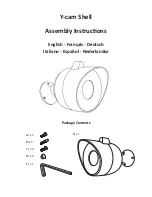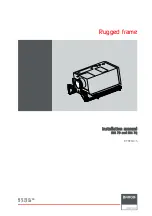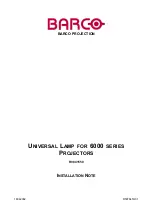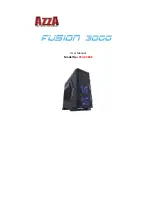
SSE-TN1W_UC [GB/FR] 4-534-240-11(1)
Français
Getting Started
Scan the code to access the “Start
Guide” and “Help Guide” online.
http://rd1.sony.net/sports/tn1/fr_sg/
What Start Guide explains
• Charging the sensor
• Attaching the sensor to a racket
• Downloading the app
Customise the app
• Initial settings
• Registering your profile and racket type, etc.
DONE!
Enjoy a new tennis experience!
For details and FAQ about how to use the sensor, please refer to the “Help
Guide” online.
Package contents
What’s included in the box
Sensor
(SSE-TN1)
Attachment (2)
Cradle
Cradle cap
Micro-USB cable
Detachment tool
Carrying pouch
Reference Guide
(this document)
CAN ICES-3 B / NMB-3 B
Le présent appareil est conforme aux CNR d’Industrie Canada applicables aux
appareils radio exempts de licence.
L’exploitation est autorisée aux deux conditions suivantes : (1) l’appareil ne doit pas
produire de brouillage, et (2) l’utilisateur de l’appareil doit accepter tout brouillage
radioélectrique subi, même si le brouillage est susceptible d’en compromettre le
fonctionnement.
Cet équipement est conforme aux limites d’exposition aux rayonnements énoncées
pour un environnement non contrôlé et respecte les règles d’exposition aux
fréquences radioélectriques (RF) CNR-102 de l’IC. Cet équipement émet une énergie
RF très faible qui est considérée conforme sans évaluation du débit d’absorption
spécifique (DAS).
What is BLUETOOTH® wireless
technology?
BLUETOOTH wireless technology is a short-range wireless technology that enables
wireless data communication between digital devices.
Connecting two devices is common, but some devices can be connected to
multiple devices at the same time.
You do not need to use a cable for connection, nor is it necessary for the devices to
face one another. For example, a device can communicate via BLUETOOTH even
when it is in a bag or pocket.
Maximum communication range
BLUETOOTH wireless technology operates within a range of about 10 m (about
33 ft). Maximum communication range may shorten under the following conditions.
– There is an obstacle such as a person, metal, or wall between the devices that
are communicating.
– A wireless LAN device is in use near the system.
– A microwave oven is in use near the system.
– A device that generates electromagnetic radiation is in use near the system.
Interference from other devices
Because BLUETOOTH devices and wireless LAN (IEEE802.11b/g/n) use the same
frequency, microwave interference may occur and result in communication speed
deterioration, noise, or invalid connection if the system is used near a wireless LAN
device. In such a case, perform the following.
– Use the system at least 10 m (about 33 ft) away from the wireless LAN device.
– If the system is used within 10 m (about 33 ft) of a wireless LAN device, turn
off the wireless LAN device.
Interference to other devices
Microwaves emitting from a BLUETOOTH device may affect the operation of
electronic medical devices. Turn off the system and other BLUETOOTH devices in
the following locations, as it may cause an accident.
– where inflammable gas is present, in a hospital, train, airplane, or a gas station
– near automatic doors or a fire alarm
Notes
• To be able to use the BLUETOOTH function, the BLUETOOTH device to be
connected requires the same profile as the system’s.
Note also that even if the same profile exists, devices may vary in function
depending on their specifications.
• This system supports security capabilities that comply with the BLUETOOTH
standard to provide a secure connection when the BLUETOOTH wireless
technology is used, but security may not be enough depending on the setting. Be
careful when communicating using BLUETOOTH wireless technology.
• We do not take any responsibility for the leakage of information during
BLUETOOTH communication.
• A device featuring the BLUETOOTH function is required to conform to the
BLUETOOTH standard specified by Bluetooth SIG, and be authenticated. Even if
the connected device conforms to the above mentioned BLUETOOTH standard,
some devices may not be connected or work correctly, depending on the features
or specifications of the device.
The Bluetooth® word mark and logos are registered trademarks owned by
Bluetooth SIG, Inc. and any use of such marks by Sony Corporation is under license.
Other trademarks and trade names are those of their respective owners.
Precautions
Failure to follow the safety precautions below may cause serious injury or a fire.
This Reference Guide includes important information to avoid accidents. Keep this
Reference Guide in a location where you can access it whenever you need it. Read
carefully throughout this
Reference Guide
,
Start Guide
(on the web) and
Help
Guide
(operation manual on the web), then use the sensor safely.
For your safety
Follow the instructions below to prevent any accidents.
• Observe “Precautions”
Read the WARNING and CAUTION sections below carefully.
• Conduct a periodic inspection
Check the sensor at least once a year for any malfunction.
• Stop using when there is a malfunction
Stop using the sensor immediately and contact the nearest Sony dealer or
customer center when you notice that there is a malfunction such as the sensor
making a strange sound or there is smell/smoke coming out from the sensor.
WARNING
• Be sure to use the supplied cradle and micro-USB cable only.
• Do not incinerate or dispose the sensor and included items in fire.
• Do not disassemble the sensor.
• Keep the sensor and included items out of the reach of children.
• Do not leave, store, or charge the sensor in a place where it is exposed to high
temperature such as inside a car in direct sunlight or near a fire source.
• Do not charge the sensor when the sensor and cradle are wet.
• Do not let water or a foreign object enter the sensor and cradle.
• Do not poke the sensor and cradle with sharp objects.
CAUTION
• Do not sit down with the sensor in the back pocket of your pants.
• Do not fling the sensor.
• Do not hit the ground, net, etc. with your racket when the sensor is installed.
• Do not swallow or put the sensor and included items in your mouth.
Note on the lithium-ion battery
• Do not handle damaged or leaking lithium-ion batteries.
Notes on use
• Do not crush or expose the sensor to extreme shock such as hammering or
dropping since this is a precision device.
• Be sure to use the appropriate attachment for your racket model.
• The sensor can be used in the U.S.A and Canada.
• Do not leave the sensor in a place where it is dusty, humid, oily, smoky, steamy or
in high temperatures such as inside a car in direct sunlight. Such conditions may
damage the sensor and cause it to malfunction.
• Do not clean the sensor with water.
• Charge the battery every six months even if you do not intend to use the sensor
for a long period of time.
Customer service
For Customers in the USA
If you have any questions about this product, you may call:
Sony Customer Information Center
1-800-222-SONY (7669)
Specifications
Wireless communication standard
BLUETOOTH Ver. 3.0
Transmission output
Class2 (2.5 mW)
Maximum communication range
10 m (33 feet) or more
Radio frequency
2.4 GHz band (2.4000 GHz - 2.4835 GHz)
Modulation method
FHSS
Water and dust resistant
IP65 equivalent
Operating temperature
-5 °C – 50 °C (23 °F – 122 °F)
Charging temperature
0 °C – 40 °C (32 °F – 104 °F)
Dimensions
Φ31.3 mm (1
1
/
4
inch), Height 17.6 mm (
23
/
32
inch)
Mass
Approx. 8 g (0.28 oz)
Design and specifications are subject to change without notice.




















